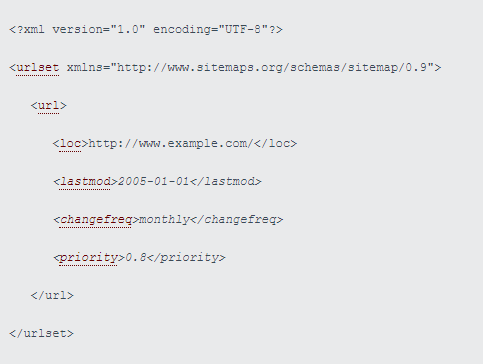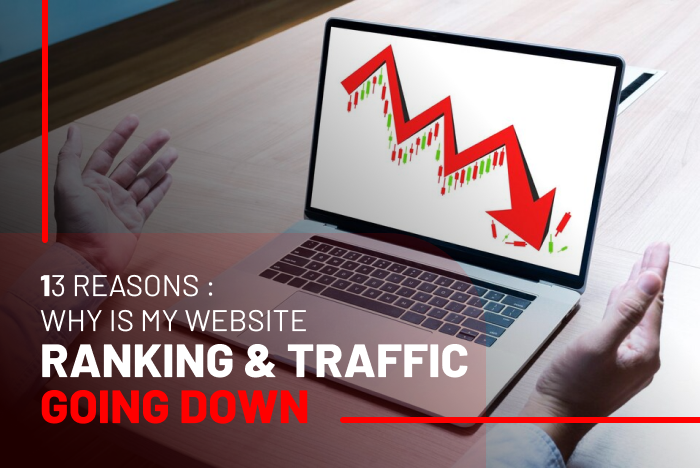Decreasing website traffic sets you up for huge losses. A decrease in website traffic may occur for a number of reasons.
The four most typical reasons for a decrease in website traffic are discussed in this piece, along with each problem's solution. Find out why your website's traffic is declining by reading on.
13 Reasons Behind Declining Website Ranking and Traffic
Due to the updated algorithm
Google doesn't try to hide the fact that it regularly issues updates, some of which are more important than others. To put it bluntly, trying to extract solid information about the changes is like trying to get blood from a stone.
However, keeping a close check on any confirmed changes from Google itself is a simple way to determine whether your site may have been affected by an algorithm update.
The wrong robots.txt directives
Are you certain that the robots.txt file on your website prevents search engines from crawling it?
After moving from a development or staging website, developers frequently leave robots.txt files alone. When this occurs, it usually happens entirely by accident.

Redirect blunders
Most websites, especially those that are big, have redirects set up. The most common way to add them is using a.htaccess file or, if you're using WordPress, a plugin to simplify your life.
I'd strongly advise testing any new permanent redirect (301) before putting it in a live environment whenever you add one to your website, especially if you're adding a lot of redirects.
I just paste my list of URLs that are being redirected into a web crawler (Screaming Frog is my go-to) and use the list mode (Mode > List) to crawl them. I then examine the response codes and ultimate destinations to ensure that redirects are still functioning as they should.
Crawl mistakes
Open the Index coverage report in the new Search Console and look for any URLs that have errors.
The index will not contain any URLs in the coverage report that are associated with errors.
Typical mistakes in this report include the following:
- Server issues
- Redirect blunders
- URLs that robots.txt prohibits
- Noindex-tagged URLs result in Soft 404 errors.
- URLs that respond to requests that are not allowed
- URLs that cannot be found (404 errors)
- Crawling mistakes
Ranking declines
A reduction in organic rankings is another very typical cause of declining website traffic.
Troubleshooting this will be much simpler if you're utilizing a rank tracker to keep track of your performance. Utilizing information from Search Console will be your finest option if you're not.
To determine any ranking changes, I go through the following procedure:
- Determine the time when traffic started to decrease using Google Analytics, Search Console, or your favorite rank tracking application.
- Export the top keywords before and after the decline.
- Create a table in Excel or Google Sheets and paste the data in it side by side.
XML Sitemap adjustments
Unless you've intentionally left redirected URLs to ensure that search engines find them more quickly, only URLs that return a 200 response and are indexable should be visible in your sitemaps if you're an SEO.
A modification to your XML sitemap may be one cause of your declining traffic.
Make sure to crawl the sitemap URLs to check that any new landing pages or articles are included, as well as that they all return a 200 OK response.
If your site has 200 URLs but the sitemap only has 50 of them, you should regenerate and resubmit the sitemap using Search Console.

De-indexing of URLs
Recently, Google Tweeted about a 'de-indexing' glitch that was reportedly causing critical pages on websites to appear to be removed from the index very immediately. But this issue has existed for a while.
Investigating a sudden drop in website traffic might be quite difficult if key URLs aren't present in the search results.
Check Search Console's index coverage report for any mistakes.
Verify that crucial pages are still included in the index by using the URL inspection tool.
If not, use Search Console's Request Indexing option.
Layout revisions for the SERP
Your traffic volumes may be impacted by a recent change in how Google and other search engines present organic results. Therefore, it would greatly help if you could adapt and were willing to adjust.
Featured Snippets, Knowledge Graphs, and increased prominence of advertisements, to name a few modifications made by Google specifically to the results presentation, have made life for SEO businesses and specialists very difficult.
Natural changes by Google or search engines
Although seeing a reduction in website traffic might be rather depressing, there is always a reason for it, and if there is a reason, it can usually be fixed.
One thing you should take away from this article is that a big reduction could result from a number of things working in concert or even just from the removal of one crucial page from the index.
If you make sure to investigate every possibility, you'll quickly identify the cause and put a recovery plan in place.
Due to competitors’ activity
Even if you are following all the appropriate procedures, it is still possible for your rankings to drop and traffic to decrease because your enemies and competitors are still there to grab the opportunity you missed.
They might be conducting their own SEO campaign, so you can check to see whether they have received a surge of new backlinks using backlink monitoring tools.
Make some of the same modifications, but do them better once you understand what your rivals did to surpass you.
Speed of the page
Your website's rankings and user experience will both be impacted by how quickly your pages' content loads. People don't want to wait to view your material, so when pages take longer to load, bounce rates are higher.
Use Google's updated PageSpeed Tool to examine your page's performance. Real user data was incorporated into the tool's redesign.
Depending on how rapidly a page loads, it is rated as fast, sluggish, or medium.
Recent website redesigns and changes
The last thing you want to happen if you decide to revamp your website is to lose the traffic and rankings you have worked so hard to establish.
Overloaded servers
Your server could overload and crash if it is not configured or ready for sudden spikes in traffic. A shared server increases the risk of going down since another user can experience an unexpected spike in traffic.
Many hosting plans will shut down your website if you go over your allotted bandwidth. If your website is successful in being featured on a well-known website, this may occur.
Your website's search rankings will suffer if it is unavailable for an extended period of time.
Conclusion:
There are no shortcuts to increasing traffic to your website. You must invest a lot of time and effort if you want to increase your search engine presence.
Avoid trying to cut corners using dubious tactics because you can end up with a bad search score and less traffic as a result.
To improve your internet exposure and expand your business, stay up-to-date on the most recent developments and best practices or you can hire an SEO service provider that can address the main causes and issues and implement effective strategies to recover your website's ranking and traffic.
Boost your website ranking and traffic with our expert SEO services. Contact us to get a Free SEO Consultation or an SEO quote.




